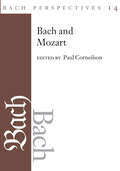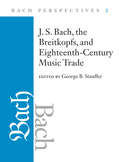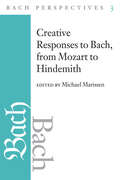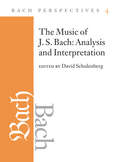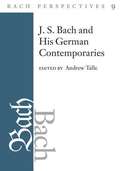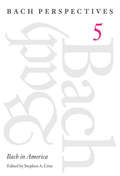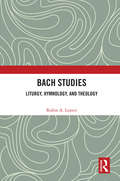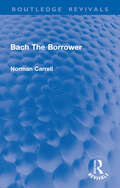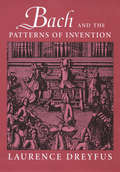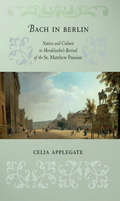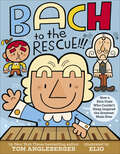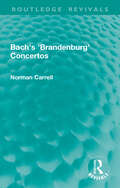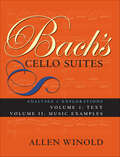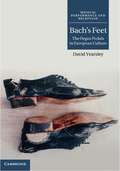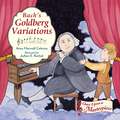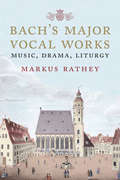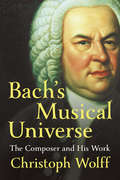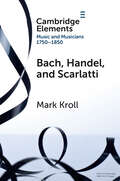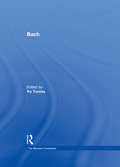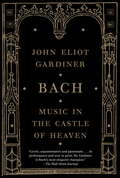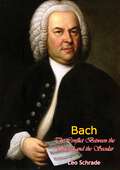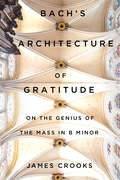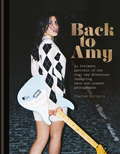- Table View
- List View
Bach Perspectives, Volume 14: Bach and Mozart: Connections, Patterns, and Pathways
by Eleanor Selfridge-Field Paul Corneilson David Schulenberg Yoel Greenberg Noelle M Heber Michael Maul Stephen RoeToday, the names Bach and Mozart are mostly associated with Johann Sebastian Bach and Wolfgang Amadeus Mozart. But this volume of Bach Perspectives offers essays on the lesser-known musical figures who share those illustrious names alongside new research on the legendary composers themselves. Topics include the keyboard transcriptions of J. S. Bach and Johann Gottfried Walther; J. S. Bach and W. A. Mozart's freelance work; the sonatas of C. P. E. Bach and Leopold Mozart; the early musical training given J. C. Bach by his father and half-brother; the surprising musical similarities between J. C. Bach and W. A. Mozart; and the latest documentary research on Mozart’s 1789 visit to the Thomasschule in Leipzig. An official publication of the American Bach Society, Bach Perspectives, Volume 14 draws on a variety of approaches and a broad range of subject matter in presenting a new wave of innovative classical musical scholarship. Contributors: Eleanor Selfridge-Field, Yoel Greenberg, Noelle M. Heber, Michael Maul, Stephen Roe, and David Schulenberg
Bach Perspectives, Volume 2: J. S. Bach, the Breitkopfs, and Eighteenth-Century Music Trade (Bach Perspectives)
by Ernest May Andreas Glöckner Hans-Joachim Schulze Neal Zaslaw George B. Stauffer Gregory G. Butler Robert M. Cammarota Peggy Daub George R. Hill Yoshitake Kobayashi Ortrun LandmannLaunched in 1995, Bach Perspectives has become the premier English-language serial book series dedicated to cutting-edge Bach scholarship. The University of Illinois Press now offers the first four volumes in open access editions available for free to all interested readers. From 1727 to 1787, the Bach and the Breitkopf families enjoyed close professional ties forged by the growing trade between music composers and music printers. The second volume of Bach Perspectives examines the inventive and far-flung activities of the Breitkopf firm from the vantage point of its commerce with J. S. Bach and his relatives. Contributors: Gregory G. Butler, Robert M. Cammarota, Peggy Daub, Andreas Glöckner, George R. Hill, Yoshitake Kobayashi, Ortrun Landmann, Ernest May, Hans-Joachim Schulze, George B. Stauffer, and Neal Zaslaw
Bach Perspectives, Volume 3: Creative Responses to Bach, from Mozart to Hindemith (Bach Perspectives)
by Walter Frisch Thomas Christensen Stephen Hinton William Kinderman Robert L. Marshall Ludwig FinscherLaunched in 1995, Bach Perspectives has become the premier English-language serial book series dedicated to cutting-edge Bach scholarship. The University of Illinois Press now offers the first four volumes in open access editions available for free to all interested readers. The third volume of the acclaimed series features a roster of scholars analyzing the crucial influence of J. S. Bach’s music upon compositions by Mozart, Beethoven, Brahms, Hindemith, and others. Throughout, the contributors highlight Bach’s subtle presence in the history of composition and illuminate the intertwined works of Bach and his successors. Contributors: Thomas Christensen, Ludwig Finscher, Walter Frisch, Stephen Hinton, William Kinderman, and Robert L. Marshall
Bach Perspectives, Volume 4: The Music of J. S. Bach: Analysis and Interpretation (Bach Perspectives)
by John Butt John Koster Alfred Mann Paul Walker Mary Oleskiewicz David Schulenberg William Renwick Gregory G. Butler Jeanne SwackLaunched in 1995, Bach Perspectives has become the premier English-language serial book series dedicated to cutting-edge Bach scholarship. The University of Illinois Press now offers the first four volumes in open access editions available for free to all interested readers. The fourth volume of Bach Perspectives analyzes J. S. Bach’s orchestral works, especially his concertos, and the interpretation and performance of his music in general. The diverse contributors come from the fields of performance, organology, music theory, and music history, and their expertise across multiple areas provides an interdisciplinary perspective to their chapters. Contributors: Gregory G. Butler, John Butt, John Koster, Alfred Mann, Mary Oleskiewicz, William Renwick, David Schulenberg, Jeanne Swack, and Paul Walker
Bach Perspectives, Volume 9: J.S. Bach and His Contemporaries in Germany
by Andrew TalleThis provocative addition to the Bach Perspectives series offers a counternarrative to the isolated genius status that J.S. Bach and his music currently enjoy. Contributors contextualize Bach by examining the output, reputation, and compositional practices of his contemporaries in Germany whose work was widely played and enjoyed in his time, including Georg Philipp Telemann, Christoph Graupner, Gottlieb Muffat, and Johann Adolf Scheibe. Essays place Bach and his work in relation to his peers, examining avenues of composition they took while he did not and showing how differing treatments of the same subjects or texts resulted in markedly different compositional results and legacies. By looking closely at how Bach's contemporaries addressed the tasks and challenges of their time, this project provides a more nuanced view of the musical world of Bach's time while revealing in more specific terms than ever how and why Bach's own music remains fresh and compelling. Contributors are Alison Dunlop, Wolfgang Hirschmann, Michael Maul, Andrew Talle, and Steven Zohn.
Bach Studies: Liturgy, Hymnology, and Theology (Contextual Bach Studies #3)
by Robin A. LeaverThis volume draws together a collection of Robin A. Leaver’s essays on Bach’s sacred music, exploring the religious aspects of this repertoire through consideration of three core themes: liturgy, hymnology, and theology. Rooted in a rich understanding of the historical sources, the book illuminates the varied ways in which Bach’s sacred music was informed and shaped by the religious, ritual, and intellectual contexts of his time, placing these works in the wider history of Protestant church music during the Baroque era. Including research from across a span of forty years, the chapters in this volume have been significantly revised and expanded for this publication, with several pieces appearing in English for the first time. Together, they offer an essential compendium of the work of a leading scholar of theological Bach studies.
Bach The Borrower (Routledge Revivals)
by Norman CarrellOriginally published in 1967, in this book the author delves deeply into the fascinating field of Bach’s music and the reasons for his ‘borrowing’, and adaptation within his oeuvre. This book, scrupulously uncontroversial in its manner, contains evidence which upends many established judgements. Whether concerned with Bach’s artistic personality or with details of his performance, this voluminous record, with commentary, of his adaptations, recompositions or transcriptions is an essential work of reference. When it was first published much of the information on the Choralgesänge and the chorals contained in or intended for the Orgelbüchlein was available for the first time in English.
Bach and the Patterns of Invention
by Laurence DreyfusIn this major new interpretation of the music of J.S. Bach, we gain a striking picture of the composer as a unique critic of his age. By reading Bach's music "against the grain" of contemporaries, Laurence Dreyfus explains how Bach's approach to musical invention posed a fundamental challenge to Baroque aesthetics.
Bach in Berlin: Nation and Culture in Mendelssohn's Revival of the "St. Matthew Passion"
by Celia ApplegateBach's St. Matthew Passion is universally acknowledged to be one of the world's supreme musical masterpieces, yet in the years after Bach's death it was forgotten by all but a small number of his pupils and admirers. The public rediscovered it in 1829, when Felix Mendelssohn conducted the work before a glittering audience of Berlin artists and intellectuals, Prussian royals, and civic notables. The concert soon became the stuff of legend, sparking a revival of interest in and performance of Bach that has continued to this day.Mendelssohn's performance gave rise to the notion that recovering and performing Bach's music was somehow "national work." In 1865 Wagner would claim that Bach embodied "the history of the German spirit's inmost life." That the man most responsible for the revival of a masterwork of German Protestant culture was himself a converted Jew struck contemporaries as less remarkable than it does us today--a statement that embraces both the great achievements and the disasters of 150 years of German history.In this book, Celia Applegate asks why this particular performance crystallized the hitherto inchoate notion that music was central to Germans' collective identity. She begins with a wonderfully readable reconstruction of the performance itself and then moves back in time to pull apart the various cultural strands that would come together that afternoon in the Singakademie. The author investigates the role played by intellectuals, journalists, and amateur musicians (she is one herself) in developing the notion that Germans were "the people of music." Applegate assesses the impact on music's cultural place of the renewal of German Protestantism, historicism, the mania for collecting and restoring, and romanticism. In her conclusion, she looks at the subsequent careers of her protagonists and the lasting reverberations of the 1829 performance itself.
Bach to the Rescue!!!: How a Rich Dude Who Couldn't Sleep Inspired the Greatest Music Ever
by Tom AnglebergerEvery famous piece of art has an origin story—even Bach’s Goldberg Variations! When the richest dude in town can’t sleep, he hires a much-less-rich dude named Johann Gottlieb Goldberg to play him lullabies on the harpsichord. Goldberg does an OK job, but as the Rich Dude hollers for Goldberg each night, he wakes up the whole town in the process. As the town gets sleepier and sleepier and grumpier and grumpier, Goldberg worries he may be out of a job soon. But then, the one and only Bach enters the scene with a series of lullabies composed specifically for the Rich Dude. And, thus, the Goldberg Variations are born! This zany, nontraditional nonfiction picture book comes from the inimitable Tom Angleberger, author of the bestselling Origami Yoda series.
Bach's 'Brandenburg' Concertos (Routledge Revivals)
by Norman CarrellOriginally published in 1963 and with a foreword by Yehudi Menuhin, this book begins with a study of the historical scene and the conditions under which Bach and his player colleagues lived, wrote and worked. It discusses the instruments then in use and required by Bach in these compositions and why certain passages in consequence took the shape or form they did. The book analyses Bach’s music and demonstrates how he built up whole movements from a single 3 or 4-note germ, and at the same time shows how the composer developed his own powers. How, for example, in addition to making any necessary changes to overcome technical deficiencies, he began to think about the musical suitability of passages given to certain instruments instead of just giving the same passage to any of the instruments he happened to have included in his concertante group. When it was first published the book was believed to be the only one in English to deal with the subject in such detail.
Bach's Cello Suites, Volumes 1 and 2: Analyses and Explorations
by Allen WinoldJ. S. Bach's Suites for Unaccompanied Cello are among the most cherished and frequently played works in the entire literature of music, and yet they have never been the subject of a full-length music analytical study. The musical examples herein include every note of all movements (so one needs no separate copy of the music while reading the book), and undertakes both basic analyses—harmonic reduction, functional harmonic analysis, step progression analysis, form analysis, and syntagmatic and paradigmatic melodic analysis—and specialized analyses for some of the individual movements. Allen Winold presents a comprehensive study intended not only for cellists, but also for other performers, music theorists, music educators, and informed general readers.
Bach's Dialogue with Modernity: Perspectives on the Passions
by John ButtProviding a detailed analysis of Bach's Passions, this book represents an important contribution to the debate about the culture of 'classical music', its origins, priorities and survival. The angles from which each chapter proceeds differ from those of a traditional music guide, by examining the Passions in the light of the mindsets of modernity, and their interplay with earlier models of thought and belief. While the historical details of Bach's composition, performance and theological context remain crucial, the foremost concern of this study is to relate these works to a historical context that may, in some threads at least, still be relevant today. The central claim of the book is that the interplay of traditional imperatives and those of early modernity renders Bach's Passions particularly fascinating as artefacts that both reflect and constitute some of the priorities and conditions of the western world.
Bach's Feet
by David YearsleyThe organist seated at the king of instruments with thousands of pipes rising all around him, his hands busy at the manuals and his feet patrolling the pedalboard, is a symbol of musical self-sufficiency yielding musical possibilities beyond that of any other mode of solo performance. In this book, David Yearsley presents a new interpretation of the significance of the oldest and richest of European instruments, by investigating the German origins of the uniquely independent use of the feet in organ playing. Delving into a range of musical, literary and visual sources, Bach's Feet demonstrates the cultural importance of this physically demanding mode of music-making, from the blind German organists of the fifteenth century, through the central contribution of Bach's music and legacy, to the newly-pedaling organists of the British Empire and the sinister visions of Nazi propagandists.
Bach's Goldberg Variations (Once Upon a Masterpiece #3)
by Anna Harwell CelenzaJohann Gottlieb Goldberg is a young servant in the employ of Count Keyserlingk. A talented musician, the boy secretly practices playing the harpsichord at night. When the count discovers Goldberg one evening, he challenges Goldberg to combine all the harpsichord music he's learned--and to throw in a riddle. In a panic, Goldberg turns to Johann Sebastian Bach for the perfect piece of music to appease the count. Stylized illustrations include elements from the baroque period. For families, teachers, and curious music lovers of all ages.
Bach's Major Vocal Works: Music, Drama, Liturgy
by Markus RatheyEvery year, Johann Sebastian Bach's major vocal works are performed to mark liturgical milestones in the Christian calendar. Written by a renowned Bach scholar, this concise and accessible book provides an introduction to the music and cultural contexts of the composer's most beloved masterpieces, including the "Magnificat, Christmas Oratorio, " and" St. John Passion. " In addition to providing historical information, each chapter highlights significant aspects-such as the theology of love-of a particular piece. This penetrating volume is the first to treat the vocal works as a whole, showing how the compositions were embedded in their original performative context within the liturgy as well as discussing Bach's musical style, from the detailed level of individual movements to the overarching aspects of each work. Published in the approach to Easter when many of these vocal works are performed, this outstanding volume will appeal to casual concertgoers and scholars alike. "
Bach's Musical Universe: The Composer And His Work
by Christoph WolffA concentrated study of Johann Sebastian Bach’s creative output and greatest pieces, capturing the essence of his art. Throughout his life, renowned and prolific composer Johann Sebastian Bach articulated his views as a composer in purely musical terms; he was notoriously reluctant to write about his life and work. Instead, he methodically organized certain pieces into carefully designed collections. These benchmark works, all of them without parallel or equivalent, produced a steady stream of transformative ideas that stand as paradigms of Bach’s musical art. In this companion volume to his Pulitzer Prize–finalist biography, Johann Sebastian Bach: The Learned Musician, leading Bach scholar Christoph Wolff takes his cue from his famous subject. Wolff delves deeply into the composer’s own rich selection of collected music, cutting across conventional boundaries of era, genre, and instrument. Emerging from a complex and massive oeuvre, Bach’s Musical Universe is a focused discussion of a meaningful selection of compositions—from the famous Well-Tempered Clavier, violin and cello solos, and Brandenburg Concertos to the St. Matthew Passion, Art of Fugue, and B-minor Mass. Unlike any study undertaken before, this book details Bach’s creative process across the various instrumental and vocal genres. This array of compositions illustrates the depth and variety at the essence of the composer’s musical art, as well as his unique approach to composition as a process of imaginative research into the innate potential of his chosen material. Tracing Bach’s evolution as a composer, Wolff compellingly illuminates the ideals and legacy of this giant of classical music in a new, refreshing light for everyone, from the amateur to the virtuoso.
Bach's Numbers
by Ruth TatlowIn eighteenth-century Germany the universal harmony of God's creation and the perfection of its proportions still held philosophical, moral and devotional significance. Reproducing proportions close to the unity (1:1) across compositions could render them beautiful, perfect and even eternal. Using the principles of her groundbreaking theory of proportional parallelism and the latest source study research, Ruth Tatlow reveals how Bach used the number of bars to create numerical perfection across his published collections, and explains why he did so. The first part of the book illustrates the wide-ranging application of belief in the unity, showing how planning a well-proportioned structure was a normal compositional procedure in Bach's time. In the second part Tatlow presents practical demonstrations of this in Bach's works, illustrating the layers of proportion that appear within a movement, a work, between two works in a collection, across a collection and between collections.
Bach, Handel and Scarlatti: Reception in Britain 1750–1850 (Elements in Music and Musicians 1750–1850)
by Mark KrollThe music of Johann Sebastian Bach, George Frederic Handel and Domenico Scarlatti received more performances, publications and appreciation in Britain between 1750–1850 than in any other country during this era. The compositions of these three seminal baroque composers were heard in the numerous public and private concerts that proliferated at this time; edited, arranged and published for professionals and amateurs; written about by scholars and journalists; and used as teaching pieces and in pedagogical treatises. This Element examines the reception of their music during this dynamic period in British musical history, and places the discussion within the context of the artistic, cultural, economic, and political factors that stimulated such passionate interest in 'ancient music.' It also offers a vivid picture of the aesthetic concerns of those musicians and audiences involved with this repertoire, providing insights that help us better understand our own encounters with music of the past.
Bach: A Guide To The Study Of Bach's '48' (The\baroque Composers Ser. #4)
by Yo TomitaFor nearly two centuries Johann Sebastian Bach has been regarded as a cornerstone of Western musical culture. His music inspired subsequent generations of composers and philosophers alike, and continues to capture our imaginations in many ways. Bach studies is part of this picture, often seen as providing excellent examples of musicological scholarship. The volume editor has chosen thirty-one published articles which, in his view, not only represent a broad spectrum of the scholarly discussions on Bach's life and works, but will also facilitate the on-going study of Bach's creative genius. The articles have been selected to ensure that this volume will be considered useful for not only those students who are currently engaging in Bach studies at universities but also for more seasoned Bach scholars as they consider the future direction of Bach studies.
Bach: Music in the Castle of Heaven
by John Eliot GardinerJohann Sebastian Bach is one of the most unfathomable composers in the history of music. How can such sublime work have been produced by a man who (when we can discern his personality at all) seems so ordinary, so opaque--and occasionally so intemperate? John Eliot Gardiner grew up passing one of the only two authentic portraits of Bach every morning and evening on the stairs of his parents' house, where it hung for safety during World War II. He has been studying and performing Bach ever since, and is now regarded as one of the composer's greatest living interpreters. The fruits of this lifetime's immersion are distilled in this remarkable book, grounded in the most recent Bach scholarship but moving far beyond it, and explaining in wonderful detail the ideas on which Bach drew, how he worked, how his music is constructed, how it achieves its effects--and what it can tell us about Bach the man. Gardiner's background as a historian has encouraged him to search for ways in which scholarship and performance can cooperate and fruitfully coalesce. This has entailed piecing together the few biographical shards, scrutinizing the music, and watching for those instances when Bach's personality seems to penetrate the fabric of his notation. Gardiner's aim is "to give the reader a sense of inhabiting the same experiences and sensations that Bach might have had in the act of music-making. This, I try to show, can help us arrive at a more human likeness discernible in the closely related processes of composing and performing his music." It is very rare that such an accomplished performer of music should also be a considerable writer and thinker about it. John Eliot Gardiner takes us as deeply into Bach's works and mind as perhaps words can. The result is a unique book about one of the greatest of all creative artists.
Bach: The Conflict Between the Sacred and the Secular
by Leo SchradeEminent musician and musical scholar Leo Schrade reflects on Bach and his music.“UNDERSTANDING AND esteem for Bach’s music have developed in a way not altogether regular. The course of men’s appreciation of Bach has moved back and forth, like the tides. The causes that have set these tides in motion have changed from time to time. Hence we always think we are “discovering” Bach anew. If signs are not wholly deceptive, a new wave seems to be rising here and now. A new historical interpretation may therefore be worthwhile.Whenever in the past historical explanation has claimed to reveal the most ultimate and profound secrets of Bach’s music, it has been only in the most general terms that the scholar, the historian, the philosophical interpreter have been able to fathom the depths of his work. Its sum and substance have been held to consist in the force of its religious quality, its spiritual power, its profundity of feeling, its abundance of humanity. We accept these terms as entirely appropriate. It seems that all who have a mind for his music draw upon such a terminology to express the ultimate and inexplicable. Such words are nebulous, and always exposed to danger; they are apt to be vague and empty. Their meaning as applied to Bach becomes clear in the light of his own historical context. Was religious quality or intensity of feeling in fact the historical import of Bach and his work? And if so, was it the real force that gave his work its form? If Bach spoke the language of religion, of human depth and feeling, we must learn to understand its significance in terms of his own situation and problems, or else it merely calls forth our subjective and uncontrolled imagination. This is the true task of historical interpretation.”-Introduction.
Bach’s Architecture of Gratitude: On the Genius of the Mass in B Minor
by James CrooksEvery lover of music finds themselves, at privileged moments, in ecstasy – certain that what they are hearing has captured, somehow, an incontrovertible truth. In Bach’s Architecture of Gratitude James Crooks explores this profound aesthetic experience in a case study of J.S. Bach’s Mass in B Minor – widely considered among the greatest works of the western choral canon.The book begins with an investigation of compositional principles – of what we might call the mass’s musical architecture. Crooks argues that in its cathedral-like structure, Bach gives us a detailed map of the spiritual journey it triggers. This journey culminates in our apprehension of the world as a gift. And that means, in turn, that the mode of knowing appropriate to its musical ecstasy is gratitude. In the gratitude of aesthetic experience, we learn something crucial about the genuine nature of our own identity, our relations with others, and the character of the things around us. Bach’s genius lies in his capacity to frame these lessons in the mass’s choruses, solos, and duets.Spotlighting the wisdom embedded in gratitude, Bach’s Architecture of Gratitude celebrates music as a pathway to understanding our deepest selves and our intimacy with the world.
Back to Amy
by Charles Moriarty'...it's really quite beautiful' Matt Everitt, BBC Radio 6 MusicHappy, beautiful and full of fun - this is an intimate portrait of the real Amy Winehouse.With over 100 photographs - many seen here for the first time - along with personal stories and recollections from Amy's mother, Janis Winehouse, as well as Amy's band members and others close to her, this is a celebration of a young artist on the cusp of fame. Taken by a friend at a relaxed photoshoot just before she released her debut album, these beautiful images give an early glimpse of the girl who would captivate the world.With a foreword by Asif Kapadia, director of Academy Award-winning documentary Amy, and containing fond memories and insights from the people who knew her best, Back to Amy is a tribute to the enduring spirit of a truly special artist.
